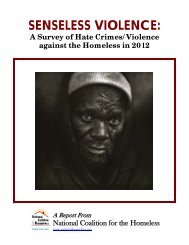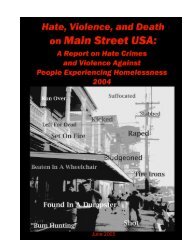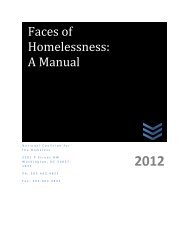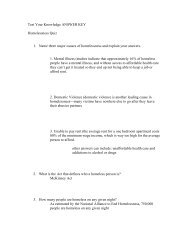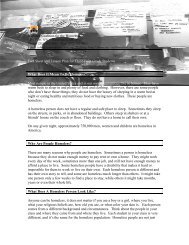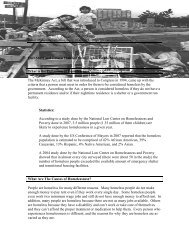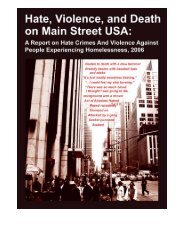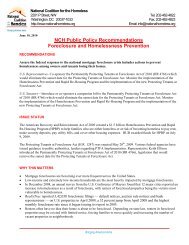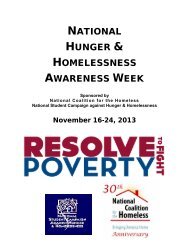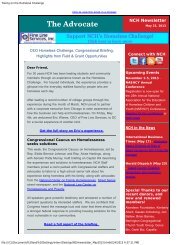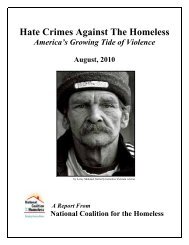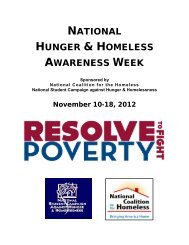HATE, VIOLENCE, AND DEATH ON MAIN STREET <strong>USA</strong>2008Recognizing Anti-Homeless <str<strong>on</strong>g>Violence</str<strong>on</strong>g> As <str<strong>on</strong>g>Hate</str<strong>on</strong>g> CrimeBy Professor Brian LevinCenter for the Study of <str<strong>on</strong>g>Hate</str<strong>on</strong>g> & Extremism, California State University, San BernardinoEven before a new exp<str<strong>on</strong>g>and</str<strong>on</strong>g>ed federal hate crime law wound its way through Washingt<strong>on</strong>, DC thisyear, history of another sort was quietly being made in another capital about 30 miles away.Maryl<str<strong>on</strong>g>and</str<strong>on</strong>g>, <strong>on</strong>e of the first states in the country to implement laws <str<strong>on</strong>g>and</str<strong>on</strong>g> statewide data collecti<strong>on</strong>m<str<strong>on</strong>g>and</str<strong>on</strong>g>ates relating to hate crime in the 1980s, became the first state to n<strong>on</strong>-discreti<strong>on</strong>ally addhomeless status to its hate crime law <strong>on</strong> May 7, 2009 with the str<strong>on</strong>g <str<strong>on</strong>g>and</str<strong>on</strong>g> persistent leadership ofState Senator Alex Mo<strong>on</strong>ey (R- Frederick, MD). Other jurisdicti<strong>on</strong>s such as Los Angeles County,Seattle, Clevel<str<strong>on</strong>g>and</str<strong>on</strong>g>, California, <strong>Main</strong>e, Puerto Rico, <str<strong>on</strong>g>and</str<strong>on</strong>g> Alaska have also taken various steps torecognize homeless status in their laws or procedures, in recent years, but Maryl<str<strong>on</strong>g>and</str<strong>on</strong>g>’s acti<strong>on</strong> is themost sweeping of any jurisdicti<strong>on</strong> to date. In almost <strong>on</strong>e dozen other states, including California,Texas, <str<strong>on</strong>g>and</str<strong>on</strong>g> Florida, legislati<strong>on</strong> has been introduced over the past four years to amend their hatecrime statutes to include homeless status as a category as well. On July 31, the District of Columbiapassed a bill to protect the homeless in its hate crime law. On August 6, it was signed into law bythe Mayor.<str<strong>on</strong>g>Hate</str<strong>on</strong>g> Crime Definiti<strong>on</strong><str<strong>on</strong>g>Hate</str<strong>on</strong>g> crimes are discriminatory crimes where a substantial part of the motive is the actual orperceived status characteristic of another. Discriminati<strong>on</strong> refers to the unequal treatment of peoplebased <strong>on</strong> their membership in a group. The term “hate crime” itself is somewhat of a misnomer,because in the United States, abstract n<strong>on</strong>-threatening expressi<strong>on</strong>s of bigotry are not criminallypunishable. In the over 45 states that have hate crime laws, intenti<strong>on</strong>ally selecting a crime victimdue to a socially recognizable status characteristic is either a distinct criminal offense itself or afactor that increases <strong>on</strong>e’s sentence up<strong>on</strong> c<strong>on</strong>victi<strong>on</strong> for an underlying offense like assault. Virtuallyevery state statute initially protected <strong>on</strong> the basis of race, religi<strong>on</strong> <str<strong>on</strong>g>and</str<strong>on</strong>g> ethnicity. As time passedstate legislatures began to recognize that the protecti<strong>on</strong>s in their hate crime laws excluded variousother groups singled out for prejudice related violence. The next phase of hate crime legislati<strong>on</strong> wasto increase the number of protected groups in both existing statutes <str<strong>on</strong>g>and</str<strong>on</strong>g> proposed legislati<strong>on</strong>.Currently, about 32 states protect <strong>on</strong> the basis of sexual orientati<strong>on</strong>, 28 <strong>on</strong> the basis of gender <str<strong>on</strong>g>and</str<strong>on</strong>g>less than 10 include disability. A key provisi<strong>on</strong> of the Mathew Shepard <str<strong>on</strong>g>Hate</str<strong>on</strong>g> Crimes Preventi<strong>on</strong> Actof 2009 was the additi<strong>on</strong> of various protected categories such as sexual orientati<strong>on</strong>, gender, genderidentity <str<strong>on</strong>g>and</str<strong>on</strong>g> disability to federal hate crime law. In 2007, the FBI reported 7,624 hate crimes <strong>on</strong> thebasis of race, religi<strong>on</strong>, ethnicity, sexual orientati<strong>on</strong>, <str<strong>on</strong>g>and</str<strong>on</strong>g> disability. Of the 9,535 victims targeted, 10were killed. A 2005 Bureau of Justice Statistics study put the number of annual hate crime incidentsat a much higher level, 191,000-largely owing to obstacles relating to reporting <str<strong>on</strong>g>and</str<strong>on</strong>g> recordati<strong>on</strong>. In2008, the Nati<strong>on</strong>al Coaliti<strong>on</strong> for the Homeless reported that 106 homeless people were victims ofhate crimes, 27 of which resulted in death.The Origins of <str<strong>on</strong>g>Hate</str<strong>on</strong>g> Crime LawsThe precursors of c<strong>on</strong>temporary hate crime statutes extend back to the post Civil War period whencivil rights laws were enacted to protect the exercise of various rights from racially based violence<str<strong>on</strong>g>and</str<strong>on</strong>g> intimidati<strong>on</strong>. Over time some laws revolved around punishing interference with the exercise ofvarious basic rights, such as using public thoroughfares, voting <str<strong>on</strong>g>and</str<strong>on</strong>g> housing without reference to the35
HATE, VIOLENCE, AND DEATH ON MAIN STREET <strong>USA</strong>2008group characteristic of a potential victim. In other instances, laws focused less <strong>on</strong> the right a victimwas exercising, but instead <strong>on</strong> his or her group status characteristic. It is noteworthy to thec<strong>on</strong>temporary discussi<strong>on</strong> of homeless status to recognize that housing <str<strong>on</strong>g>and</str<strong>on</strong>g> the use of thoroughfareshas been a l<strong>on</strong>gst<str<strong>on</strong>g>and</str<strong>on</strong>g>ing protected civil right.While a small number of older state statutes resembled the federal models, modern state statutestended to be broader in their applicati<strong>on</strong>. These laws include protecti<strong>on</strong> <strong>on</strong> the basis of a victim’sreal or perceived group status. Structurally, hate crime laws are of two main types, those thatenhance the penalty for underlying offenses, <str<strong>on</strong>g>and</str<strong>on</strong>g> those that can be charged independently withoutthe necessity of levying another charge. In Wisc<strong>on</strong>sin v. Mitchell, 508 U.S. 476 (1993), the UnitedStates Supreme Court unanimously affirmed the c<strong>on</strong>stituti<strong>on</strong>ality of properly drafted hate crimepenalty enhancement laws. In the case, Apprendi v. New Jersey, 530 U.S. 466 (2000), the Courtruled that in most instances discriminatory victim selecti<strong>on</strong> must be established bey<strong>on</strong>d a reas<strong>on</strong>abledoubt.Invisible <str<strong>on</strong>g>Hate</str<strong>on</strong>g> Crimes: The Homeless PeoplePerhaps the greatest tragedy of homelessness is the astr<strong>on</strong>omical level <str<strong>on</strong>g>and</str<strong>on</strong>g> frequency of violentattack that these individuals face. Studies from the United States <str<strong>on</strong>g>and</str<strong>on</strong>g> Canada indicate that homelessindividuals face an annual risk of criminal victimizati<strong>on</strong> as high as 66% to 82%, about the highestfor any subgroup in the industrialized world. Some of the victimizati<strong>on</strong>s against homeless peoplerelate to their actual physical lack of shelter, their locati<strong>on</strong> in higher crime areas, disability, as wellas risks associated with relati<strong>on</strong>ships <str<strong>on</strong>g>and</str<strong>on</strong>g> activities that occur <strong>on</strong> the street.However, over the last ten years a clear <str<strong>on</strong>g>and</str<strong>on</strong>g> alarming pattern has emerged that show the homelesspopulati<strong>on</strong> face an additi<strong>on</strong>al risk of extreme violence. Unprovoked targeted attacks bypredominantly domiciled young males assailants that do not involve robbery, pers<strong>on</strong>al disputes, ordrug dealing have claimed the lives of over 200 men <str<strong>on</strong>g>and</str<strong>on</strong>g> women nati<strong>on</strong>ally over the past decade.Methods include blunt force trauma, shootings, maiming, drowning, stabbings, <str<strong>on</strong>g>and</str<strong>on</strong>g> the burning ofvictims alive. Some of these individual cases <str<strong>on</strong>g>and</str<strong>on</strong>g> sporadic media coverage have brought theproblem of bias-related violence against homeless people to the attenti<strong>on</strong> of legislators. However,an important partnership between advocacy groups such as Nati<strong>on</strong>al Coaliti<strong>on</strong> for the Homeless(NCH) <str<strong>on</strong>g>and</str<strong>on</strong>g> researchers has shed additi<strong>on</strong>al light <strong>on</strong> the severe extent of the problem. Our Center inc<strong>on</strong>juncti<strong>on</strong> with NCH has found that there were twice as many homeless people killed in apparentbias related attacks than the combined total of every other hate crime category reported by the FBIin the last decade. This anti-homeless data actually excludes some of the other deadly violence thathomeless people experience because attacks involving drugs, pers<strong>on</strong>al disputes, robbery, insurancefraud <str<strong>on</strong>g>and</str<strong>on</strong>g> homeless <strong>on</strong> homeless violence are not tabulated. While there have been many more n<strong>on</strong>homicideattacks, including rapes <str<strong>on</strong>g>and</str<strong>on</strong>g> aggravated assaults, the homicide data, which also representsa probable undercount, is c<strong>on</strong>sidered the most reliable of all offense data.Class-based violent prejudice against homeless people has become so entrenched in youth culturethat it spawned a series of popular mass marketed videos, internet web pages, amateur youtubevideos <str<strong>on</strong>g>and</str<strong>on</strong>g> its own sport label: “bum hunting.” Moreover, class-based anti-homeless prejudice isfrequently overlaid <strong>on</strong> top of other prejudices such as race, gender, homophobia, <str<strong>on</strong>g>and</str<strong>on</strong>g> mental illness36
- Page 1 and 2: HATE, VIOLENCE, AND DEATH ON MAIN S
- Page 3 and 4: HATE, VIOLENCE, AND DEATH ON MAIN S
- Page 5 and 6: HATE, VIOLENCE, AND DEATH ON MAIN S
- Page 7 and 8: HATE, VIOLENCE, AND DEATH ON MAIN S
- Page 9 and 10: HATE, VIOLENCE, AND DEATH ON MAIN S
- Page 11 and 12: HATE, VIOLENCE, AND DEATH ON MAIN S
- Page 13 and 14: HATE, VIOLENCE, AND DEATH ON MAIN S
- Page 15 and 16: HATE, VIOLENCE, AND DEATH ON MAIN S
- Page 17 and 18: HATE, VIOLENCE, AND DEATH ON MAIN S
- Page 19 and 20: HATE, VIOLENCE, AND DEATH ON MAIN S
- Page 21 and 22: HATE, VIOLENCE, AND DEATH ON MAIN S
- Page 23 and 24: HATE, VIOLENCE, AND DEATH ON MAIN S
- Page 25 and 26: HATE, VIOLENCE, AND DEATH ON MAIN S
- Page 27 and 28: HATE, VIOLENCE, AND DEATH ON MAIN S
- Page 29 and 30: HATE, VIOLENCE, AND DEATH ON MAIN S
- Page 31 and 32: HATE, VIOLENCE, AND DEATH ON MAIN S
- Page 33 and 34: HATE, VIOLENCE, AND DEATH ON MAIN S
- Page 35: HATE, VIOLENCE, AND DEATH ON MAIN S
- Page 39 and 40: HATE, VIOLENCE, AND DEATH ON MAIN S
- Page 41 and 42: HATE, VIOLENCE, AND DEATH ON MAIN S
- Page 43 and 44: HATE, VIOLENCE, AND DEATH ON MAIN S
- Page 45 and 46: HATE, VIOLENCE, AND DEATH ON MAIN S
- Page 47 and 48: HATE, VIOLENCE, AND DEATH ON MAIN S
- Page 49 and 50: HATE, VIOLENCE, AND DEATH ON MAIN S
- Page 51 and 52: HATE, VIOLENCE, AND DEATH ON MAIN S
- Page 53 and 54: HATE, VIOLENCE, AND DEATH ON MAIN S
- Page 55 and 56: HATE, VIOLENCE, AND DEATH ON MAIN S
- Page 57 and 58: HATE, VIOLENCE, AND DEATH ON MAIN S
- Page 59 and 60: HATE, VIOLENCE, AND DEATH ON MAIN S
- Page 61 and 62: HATE, VIOLENCE, AND DEATH ON MAIN S
- Page 63 and 64: HATE, VIOLENCE, AND DEATH ON MAIN S
- Page 65 and 66: HATE, VIOLENCE, AND DEATH ON MAIN S
- Page 67 and 68: HATE, VIOLENCE, AND DEATH ON MAIN S
- Page 69 and 70: OCTOBERHATE, VIOLENCE, AND DEATH ON
- Page 71 and 72: HATE, VIOLENCE, AND DEATH ON MAIN S
- Page 73 and 74: HATE, VIOLENCE, AND DEATH ON MAIN S
- Page 75 and 76: HATE, VIOLENCE, AND DEATH ON MAIN S
- Page 77 and 78: HATE, VIOLENCE, AND DEATH ON MAIN S
- Page 79 and 80: HATE, VIOLENCE, AND DEATH ON MAIN S
- Page 81 and 82: HATE, VIOLENCE, AND DEATH ON MAIN S
- Page 83 and 84: HATE, VIOLENCE, AND DEATH ON MAIN S
- Page 85 and 86: HATE, VIOLENCE, AND DEATH ON MAIN S
- Page 87 and 88:
HATE, VIOLENCE, AND DEATH ON MAIN S
- Page 89 and 90:
HATE, VIOLENCE, AND DEATH ON MAIN S
- Page 91 and 92:
HATE, VIOLENCE, AND DEATH ON MAIN S
- Page 93 and 94:
HATE, VIOLENCE, AND DEATH ON MAIN S
- Page 95 and 96:
HATE, VIOLENCE, AND DEATH ON MAIN S
- Page 97 and 98:
HATE, VIOLENCE, AND DEATH ON MAIN S



